| |
Whether it is a matter of under-reporting or a greater focus on Atlantic Coast, Texas or Interior Seaway marine faunas, the Mississippian Embayment's rich Cretaceous fossil history tends to slip under the radar. The Santonian record of this area (including Alabama) and New Mexico are poorly reflected in commonly published faunas. In this webpage, we will attempt to document the diversity of Mississippi's Late Cretaceous marine selachian faunas. The inital version will be Late Campanian/Maastrichtian-centric, but will slowly incorporate earlier taxa.
STRATIGRAPHIC OVERVIEW
In Mississippi, Upper Cretaceous or Gulfian, deposits outcrop only in the northeastern quarter of the state. A geologic map (3 mb) of Mississippi shows surface exposures of Gulfian deposits in various hues of green (the standardized geologic map color for Upper Cretaceous deposits). The total thickness of the Gulfian sequence in Mississippi varies between 1,000 and 2,000+ feet, the thickest part lying in east-central Mississippi (Stephenson & Monroe 1940, Russell 1975, Russell & Keady 1983). The Gulfian outcrop belt within the state has a maximum width of about 50 miles (Stephenson & Monroe 1940) and stretches from the Tennessee line to west-central Alabama. The dip of these sediments averages about 30 feet per mile (Stephenson & Monroe 1940).
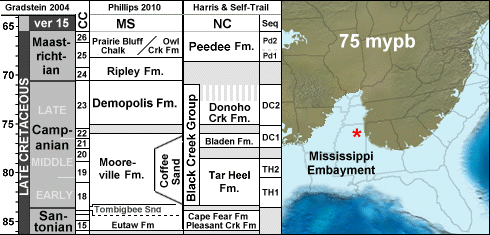 |
| Correlation chart integrated by Jim Bourdon 2008.
Paleomap modified with Manning (2006) and reproduced with the permission of Dr. Blakey 2007. |
The Gulfian sequence in Mississippi (and Alabama) consists of three formational groups. From lowest (oldest) to highest (youngest), these are the Tuscaloosa, Eutaw, and Selma Groups. The Eutaw and Selma Group sediments are entirely of marine origin, whereas the Tuscaloosa Group contains many nonmarine, paralic beds, including fluviatile deposits. Fossil bed types within the Gulfian sequence of Mississippi include those dominated by calcitic mollusks, aragonitic mollusks, moldic mollusks, bones, bones & mollusks, burrows/traces, and/or lignitized plant remains. Vertebrate remains are scattered throughout the Mississippi Gulfian section, but in places they are concentrated in marine bone beds, some of which may be rich in mollusks as well. Bone beds are also populated by inorganic constituents, like pebbles of terrestrial, marine, and biologic origin. Such accumulations of hard, gravelly constituents are called lags and include the type associated with marine transgressions. Marine vertebrates are relatively common and nearly ubiquitous in most of the Mississippi marine section. Nonmarine vertebrates occasionally make their way into marine deposits and may occur anywhere in the Gulfian section. Marine and nonmarine vertebrates in bone bed lags frequently contain vertebrate (and possibly invertebrate and plant) remains 'reworked' from a wide variety of environments, including terrestrial, freshwater, brackish, marginal marine, shallow marine, and/or deep marine situations. Dinosaurs, lungfish, freshwater turtles, crocodiles, gar, pelagic fish, sea turtles, stenotopic marine invertebrates, and lignitized arboreal products have been found mixed together in Mississippi Cretaceous marine lags. Several examples of vertebrate-rich Cretaceous marine lags occurring in Mississippi are described in Manning (2006).
CHONDRICHTHYAN FAUNA
| | | | |
| CLICK ON IMAGES FOR ADDITIONAL DETAILS |
| HYBODONTIFORMES |
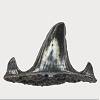 |
[L. Sant & L Camp] Common in shallow-water marine beds. Known mostly from tooth crowns, less so from dorsal fin spine frags. and cephalic hooks.
|
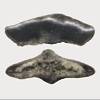 |
[L Sant & L Camp] Associated with transgressive lags; generally limited to rootless worn crowns (hybodont tooth roots are poorly permineralized and preserve only rarely). The genus is known from estuarine sites in the American West. Scarce to uncommon in Mississippi.
|
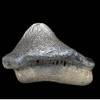 |
Ptychodus mortoni AGASSIZ, 1839
[L Sant] An indicator of a clear, deep-water marine habitat ; likely feeding on inoceramid clams. One of very few Mississippi forms to become extinct so early. Common when present.
|
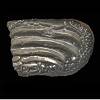 |
Ptychodus polygyrus AGASSIZ, 1839
[L Sant] Known only from a single lateral tooth from Mississippi, this deep-water marine taxon is far better known from the same-aged beds (Tombigbee Sand and basal Mooreville) of Alabama (including huge symphyseal teeth). First reported from Alabama in 1850.
|
| HEXANCHIFORMES |
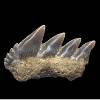 |
Hexanchus microdon (AGASSIZ, 1843)
[L Mass] |
A deepwater taxon, only two fragmentary specimens from the Prairie Bluff Formation (Late Maastrichtian) of Mississippi are known; rare.
|
| SQUATINFORMES |
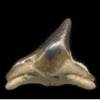 |
[U Sant - L Camp] | Angel shark teeth (shallow-water ambush predator) are uncommon in the Tombigbee Sand (Late Santonian) and common in the F-town fauna of the Demopolis Fm. (early Late Campanian).
|
| HETERODONTFORMES |
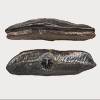 |
[L Camp] | Horn shark teeth and dorsal fin spines are known only from a few Frankstown specimens and deemed rare. This shallow-water marine genus is better known from more northern, colder-water sites.
|
| ORECTOLOBIFORMES |
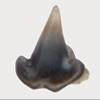 |
L Sant., M-L Camp. |
Bamboo sharks are known from their tiny (<2 mm) teeth which may or may not represent the same taxon from older and deeper waters of the Interior Seaway. They are scarce in the Eutaw and Demopolis Fms.
|
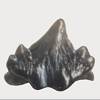 |
L Sant., M-L Camp. |
Primitive nurse shark best known from the Vinton Bluff and Frankstown transgressive lag faunas. Teeth from this durophagous dentition are usually uncommon. Habitat likely shallow-water marine.
|
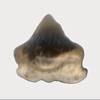 |
L. Camp |
This species is represented by a single Frankstown specimen (Demopolis Fm, early Late Campanian).
|
| ANACORACIDS |
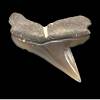 |
[L Sant. - L Camp]
Better known from Texas than Mississippi these teeth are widespread in low numbers in Mississippi; surprisingly, absent from the Frankstown fauna (the most diverse Cretaceous fauna in the state).
|
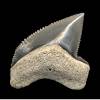 |
L Sant - L Camp. |
Common in the Tombigbee Sand (Late Santonian), Coffee Sand (Early-Middle Campanian) and Demopolis Fm.(ealy Late Campanian). [Meyer's (1974) Squalicorax kaupi.]
|
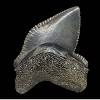 |
L Sant. |
Most common crow shark in certain Tombigbee Sand, Eutaw Fm. faunas. Teeth characterized by the knotch or concavity on the lower mesial cutting edge and inflated mesial serrations. [Meyer's (1974) Squalicorax sp aff S. kaupi (in part).]
|
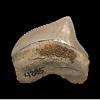 |
[L Camp & L Maas] Uncommon in the Demopolis (Late Campanian) and common in the Prairie Bluff (Late Maastrichtian) Formations. Teeth large with an obtuse distal knotch; serrations most commonly simplex (less frequently compound).
|
| LAMNIFORMES |
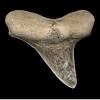 |
[L Sant. - E Camp] Uncommon and limited to what are thought to be deeper water sediments. Specimens compare very well with those of Eastman 1894.
|
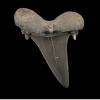 |
L Sant. - late L Camp. | Along the Coastal Plain, the most abundant shark tooth of Campanian faunas. In large numbers, an indicator of shallow-water (rarely in deep-water sites). This genus is gone in the Maastrichtian.
|
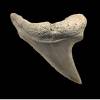 |
[L Sant. & L Camp] More common in the Tombigbee Sand lag than in the mid-Demopolis one, suggesting the former was closer to deep water. Generally scarce to uncommon.
|
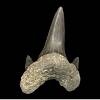 |
This tooth-design is represented by a single Frankstown (eL. Campanian) specimen. Based on its much greater abundance in NJ, this is likely a colder water taxon.
|
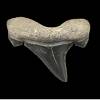 |
Common in Tombigbee Sand (Late Santonian), uncommon at Frankstown (Demopolis Fm, early Late Campanian) and rare in Bluffport Marl (late Late Campanian).
|
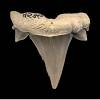 |
Prinarily known from Maastrictian sites, what appears to be a more primitive version of this tooth-design is found in the Demopolis Fm. (e L Camp).
|
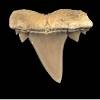 |
This distinctive tooth-design with assymetrical shoulders is primariy known from Maastricthian horizons. A primitive version of this tooth-design is represented in the Frankstown fauna (Demopolis Fm, e L Camp).
|
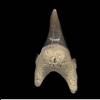 |
A single specimen has been identitied from the Frankstown (Demopolis Fm., early Late Cretaceous) fauna.
|
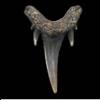 |
Odontaspis aculeatus (CAPPETTA & CASE, 1975)
This striated tooth-design is more reminiscent of O. ferox with its long slender cusplets. These teeth are scarce and usually worn/damaged. Also see:
sorting Late Cretaceous sand tigers. Known from the Framnkstown fauna (early Late Campanian) where it is uncommon to scarce.
|
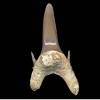 |
? Odontaspis sp
[L Camp] This smooth-crowned tooth-design is Odontapis-like with a narrow crown & elongated cusplets.
|
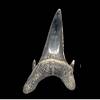 |
Scarce to uncommon at Frankstown (Demopolis Fm., eL Camp) and stream-collected (?Maas) sediments. Case & Cappetta (1997: 141) discuss this broad cusp (striated) variation as holmdelensis and not C. cheathami (CASE 1987). Also see: sorting Late Cretaceous sand tigers.
|
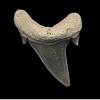 |
Known only from the Frankstown fauna (Demopolis Fm., early Late Campanian) where it is deemed scarce to uncommon. Smooth crown. Also see:
sorting Late Cretaceous sand tigers. |
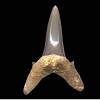 |
This smooth-crowned tooth-design is known only from the Prairie Bluff Fm (L Maas). With its short triangular cusplets and strong roots it compares well with contemporary material from Texas.
|
| CARCHARHINIFORMES |
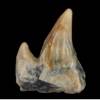 |
? Scyliorhinus sp
L Sant. |
Limited to a singular damaged example from the lower Eutaw Fm.
|
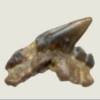 |
Palaeogaleus navarroensis CASE & CAPPETTA, 1997
Known from a single stream-collected specimen thought to originate from the Prairie Bluff Fm (L. Maas).
|
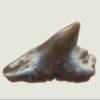 |
Galeorhinus aff girardoti HERMAN, 1977
Represented by a single stream-collected water-worn specimen -- Prairie Bluff Fm (L. Maas).
|
| SCLERORHYNCHIFORMES |
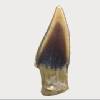 |
[L Camp, Maas] | Known only from rostral denticles, they are generally most abundant in reworked Maastrichtian deposits, but still scarce.
|
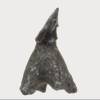 |
Borodinopristis schwimmeri CASE, 1987
[L Sant. & L Camp] A very small shallow-water marine sclerorhynchid, known in Mississippi only from the small rostral denticles, not the tiny teeth; it must have been one of the smallest durophagous elements of the fauna. It appears to become extinct before the Maastrichtian. Abundance: rare.
|
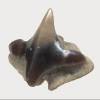 |
[L Sant - L Maas] |
One of the few Miss. Cret. elasmos to "go the distance" - survive as long as the state had a marine Cret. record. Rostral denticles are larger than the earlier I. m. schneideri, and become gradually larger over time. Material from this shallow-water taxon can be rare to common.
|
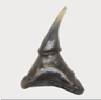 |
Ischyrhiza cf monasterica CASE & CAPPETTA 1997
[Maas] | Species represented by a single rostral denticle from reworked ?Maastrichtian sediments.
|
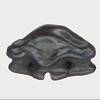 |
[L Sant., M-L Camp] Tiny shallow-water tooth-design with multiple transverse ridges; likely represented in this bucket are
P. vermiculata CAPPETTA & CASE 1975 and
P. eutawensis CASE ET AL 2001.
The tiny rostral denticles are very variable, with a heavy base and short un-barbed crown.
|
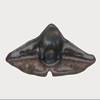 |
[L Camp] A sigular example of this small, high-cusped and smooth crown lacking labial transversse ridges is known from the Frankstown (Demopolis Fm, Late Campanian) fauna.
|
| RAJIFORMES |
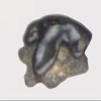 |
[L Sant, L Camp, L Maas] Guitarfish teeth are sporadically found when screening for 1mm-class specimens; actiual abundace and distribution poorly known.
|
 |
Small and uncommon in Mississippi sediments; similar to P. mcnultyi but distinguished by the stronger uvula and margino-lingual foramen.
|
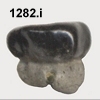 |
Common to abundant in Late Santonian to Late Campanian sediments in Mississippi.
|
| MYLIOBATIFORMES |
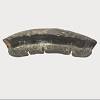 |
Brachyrhizodus wichitaensis ROMER, 1942
Common at Frankstown (Demopolis Fm, early Late Campanian) with a singular specimen known from the Ripley Fm. (Early-Middle Maastrichtian).
|
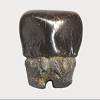 |
A common Campanian shallow-water durophagous tooth-design which is gone by the Maastrichtian. In Mississippi, it is co-present with B. wichitaensis and deemed by Manning (2006) to represent lateral positions of that taxon.
|
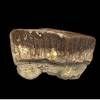 |
Rhombodus binkhorsti DAMES 1881
This shallow-water taxon is a useful indicator of Maastrichtian faunas worldwide; a durophagous form, these teeth typically have a diamond-shaped occlusal outline. They are scarce to uncommon in the Late Cretaceous of Mississippi.
|
| QUESTIONABLE ORIGIN |
| As with many sites, specimens may appear that have no explainable origin. |
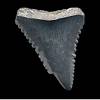 |
Palaeocarcharodon orientalis (SINZOW, 1899)
Two Palaeoarcharodon teeth have been recovered from the Frankstown site (Late Campanian); there are no nearby Paleocene sites, other Paleocene taxa have not been recognized in the fauna and P. orientalis has not been reported from Mississippi. If valid, this would be the only Cretaceous record of the taxon.
|
AKNOWLEDGEMENTS
We extend our thanks to the Mississippi Museum of Natural Sciences (MMNS) and Miss. Geological Survey (MGS) for providing specimens used in this study. Developing the underlying Cretaceous correlation chart (summarized above) was a group endeavor including the contributions of Wayne Callahan, Don Clements, David Dockery, Lucy Edwards, Bill Harris, Ralph Johnson, Earl Manning, Jean Self-Trail and Rob Weems. Ed Swiatovy provided contemporaneous Texas material when needed and Pieter DeSchutter European examples and paperwork. Mikael Siverson contributed his insights (only part of which could be included) on the anacoracids and other lamniforms. Most importantly, we thank Earl Manning; as an early participant in this project, he provided a significant insight into the Frankstown portion of this fauna.
REFERENCES
Case, G, and D. Schwimmer, 2001. Late Cretaceous fish from the Blufftown Formation (Campanian) in Western Georgia. J. Paleont. 62(2), pp 290-301
Case, G., D. Schwimmer, P. Borodin and J. Leggett, 2001. A new selachian fauna from the Eutaw Formation (Upper Cretaceous/Early to Middle Santonian) of Chattahoochee County, Georgia. Palaeontographica Abt. A, 261:83-102.
Gradstein, F., J. Ogg and A. Smith, 2004, A Geological Time Scale 2004. Cambridge University Press. 589pp.
Harris, W. and J. Self-Trail, 2006. Late Cretaceous base level lowering in Campanian and Maastrichtian depositional sequences, Kure Beach, North Carolina. Stratigraphy, vol. 3.3, pp. 195-216.
Landman, N., R. Johnson, and L. Edwards, 2004. Cephalopods from the Cretaceous/Tertiary Boundary Interval on the Atlantic Coastal Plain, with a Description of the Highest Ammonite Zones in North America. Part 1. Maryland and North Carolina. Amer. Mus. Novitates, No 3454, 64pp.
Manning, E., 2006. Late Campanian vertebrate fauna of the Frankstown site, Prentiss County, Mississippi; systematics, paleoecology, taphonomy, sequence stratigraphy. Unpub. PhD dissertation, Tulane Univ., New Orleans, xvii+419 p., 16 pls.
Manning, E. and D. Dockery III, 1992. A guide to the Frankstown vertebrate fossil locality (Upper Cretaceous), Prentiss County, Mississippi. Mississippi Dept. of Env. Qual., Office of Geology, Circular 4, 43 p., 12 pls.
Meyer, R., 1974. Late Cretaceous elasmobranchs from the Mississippi and East Texas Embayments of the Gulf Coastal Plain. Unpublished PhD dissertation, Southern Methodist University, Dallas, xiv+419 p.
Russell, E., 1975. Stratigraphy of the outcropping Upper Cretaceous in western Tennessee. Tennessee Division of Geology, 75(A):1-65.
Russell, E. and D. Keady. 1983. Notes on Upper Cretaceous lithostratigraphy of the Eastern Mississippi Embayment, p. 1-15. In E. E. Russell, D. M. Keady, E. A. Mancini, and C. C. Smith (ed.), Upper Cretaceous lithostratigraphy and biostratigraphy in northeast Mississippi, southwest Tennessee and northwest Alabama, shelf calks and coastal clastics. Gulf Coast Section of the Society of Economic Paleontologists and Mineralogists, Tuscaloosa.
Stephenson, L., and W. Monroe. 1940. The Upper Cretaceous Deposits. Mississippi Geological Survey Bulletin, 40:1-296.
Weems, R., J. Self-Trail, and L.Edwards, 2004, Supergroup Stratigraphy of the Atlantic and Gulf Coastal Plains (Middle? Jurassic through Holocene, Eastern North America). Southeastern Geology 4:2, USGS pp191-216.
|